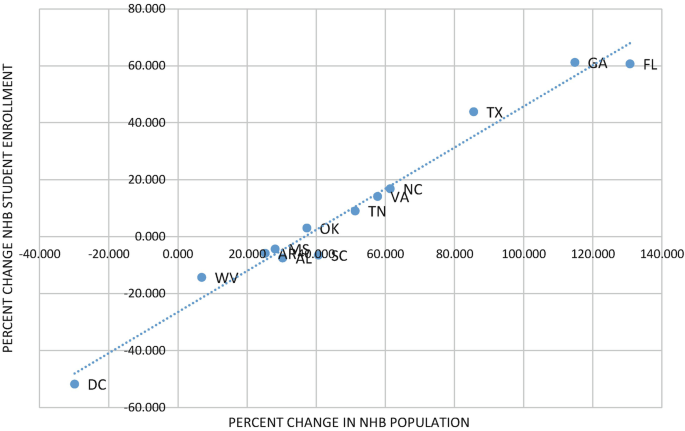Abstract
The American population was on the move, moving West and South, and continued to change the geographic distribution of the American population. The de-industrialization of the North caused many families and person to move in search of employment and affordable housing. Along with this change in the geographic distribution of the US population there was a change in the distribution of the US student population.
Access this chapter
Tax calculation will be finalised at checkout
Purchases are for personal use only
Notes
- 1.
The scattergram displays the association between NHB population change in the South and NHB student enrollment in the South.

Correlation between NHB population movement into the south and NHB student enrollment: 1980 and 2014
- 2.
For example, drop out rates by race and Hispanic origin among 12–13 year olds for the years 1980 to 2014 are displayed below.
School dropouts among 12–13 year olds by race and Hispanic origin: 1980–2014
Year
NHW
NHB
NHO
HISP
Total
1980
0.8
2.0
2.2
1.8
1.1
1990
3.3
4.4
3.5
4.2
3.6
2000
0.9
1.2
1.3
1.7
1.1
2014
1.6
1.9
1.3
1.6
1.6
- 3.
This is an estimate based on the following set of equations: 1 = (.725 + (z * x). Where z is the derivate or rate of change in the ORs from 1980 to 2014 and is equal to .003765. Thus, 1 = (.725 + (.003765*x). Solving for X we have
X = (1 −.725)/.003765 = 73.0469. Hence, it would take over 73 years for the OR to equal 1.0 or parity.
- 4.
Odds ratios are not significant if 1 is within a confidence interval—say, a 95 percent confidence interval. The formula for the upper and lower limits of a confidence interval based on a 2 x 2 table is
-
Upper limit CI = [Ln(OR) + 1.96 √(1/a + 1/b + 1/c + 1/d)]
-
Lower limit CI = [Ln(OR) − 1.96 √ (1/a + 1/b + 1/c + 1/d)]
However, it is generally the case that the t-statistic will determine the significant of the Log odds and thus the ORs.
-
- 5.
Probabilities are computed thusly. 1) P1 = c + x*B; 2) P2 = exp(P1); 3) P3 = P2 /(1 + P2).
References
Alexander, K. L., Entwisle, D. R., & Horsey, C. S. (1997). From first grade forward: Early foundations of high school dropout. Sociology of Education, 70(2), 87–107.
Anyon, J. (1981). Social class and school knowledge. Curriculum Inquiry, 11(1), 3–42.
Anyon, J. (1997). Ghetto schooling: A political economy of urban educational reform. New York: Teachers College Press.
Balfanz, R., & Legters, N. (2004). Locating the dropout crisis: Which high schools produce the nations dropouts? Where are they located? Who attends them? www.eric.ed.gov
Bowles, S., & Gintis, H. (1976). Schooling in capitalist America: Educational reform and the contradictions of economic life. New York: Basic Books.
Giroux, H. (1983). Theories of reproduction and resistance in the new sociology of education: A critical analysis. Harvard Education Review, 53(3), 257–298.
Heckman, J. J., & LaFontaine, P. A. (2007). The American high school graduation data: Trends and levels. Bonn: IZA (Institute for the Study of Labor).
Jordan, J. L., Kostandini, G., & Mykerezi, E. (2012). Rural and urban high school dropout rates: Are they different? Journal of Research in Rural Education, 27(12), 1–21.
Kolstadt, A. J., & Owings, J. A. (1986). High school dropouts who change their minds about school. Washington, DC: Office of Educational Research and Improvement.
Mc Caul, E. (1988). Rural public high school dropouts: Data from high school and beyond. Paper presented at the annual conference of New England Education Research Organization, Rockland, ME, USA.
Paasch, K. M., & Swaim, P. L. (1995). More rural students are graduating from high school, but serious dropout problems remain. Rural Development Perspectives, 10(3), 24–34.
Pallas, A. M. (1987). School dropouts in the United States. Washington, DC: NCES.
Ruiz-de-Velasco, J., & Fix, M. (2000). Overlooked and underserved: Immigrant students in U.S. secondary schools. Washington, DC: Urban Institute.
Rumberger, R.W. 1983. Dropping out of high school: The Influence of Race, Sex, and Family Background. American Educational Research Journal, 20, 2: 199–220.
Rumberger, R. W. (1987). High school dropouts: A review of issues and evidence. Educational Research, 57(2), 101–121.
Rumberger, R. W. (2011). Dropping out: Why students drop out of high school and what can be done about it. Cambridge, MA: Harvard University Press.
Rumberger, R. W. (2013). Poverty and high school dropouts. www.apa.org
Spring, J. (1976). The sorting machine. New York: Mc Kay.
Steinberg, L., Blinde, P. L., & Chan, K. S. (1984). Dropping out among language minority youth. Review of Educational Research, 54(1), 113–132.
Strange, M. (2011). Finding fairness for rural students. Kappan Magazine, 92(6), 8–15.
Verdugo, R. R. (2011). Education classes and wage inequality among US workers: 1950–2009. Sociology Mind, 1(4), 164–172.
Verdugo, R. R., & Dial, T. (2008). The demography of school dropouts. International Journal of Interdisciplinary Social Sciences, 3(8), 91–106.
Author information
Authors and Affiliations
Rights and permissions
Copyright information
© 2018 Springer International Publishing AG, part of Springer Nature
About this chapter
Cite this chapter
Verdugo, R.R. (2018). Geographic Distributions of the US Population and the Student Population During the Post 1983 Era. In: American Education and the Demography of the US Student Population, 1880 – 2014. Applied Demography Series, vol 10. Springer, Cham. https://doi.org/10.1007/978-3-319-89423-2_8
Download citation
DOI: https://doi.org/10.1007/978-3-319-89423-2_8
Published:
Publisher Name: Springer, Cham
Print ISBN: 978-3-319-89422-5
Online ISBN: 978-3-319-89423-2
eBook Packages: Social SciencesSocial Sciences (R0)


